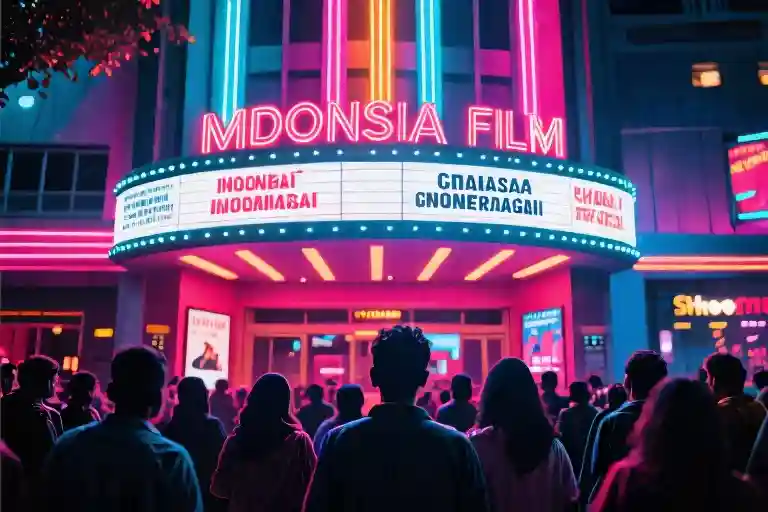I still remember the last time I rushed to see an Indonesian movie on its opening night. The trailer promised an epic historical drama with groundbreaking visuals, but what I got was two hours of awkward dialogue and shaky CGI. That experience, shared by many Indonesian moviegoers, explains why I’ve developed a healthy skepticism toward local films over the years.
It’s not that we don’t want to support our own cinema. The disappointment often comes from mismatched expectations – when over-the-top promotion meets average storytelling, or when flashy marketing can’t disguise weak scripts. Like most Indonesian film enthusiasts, I’ve learned to wait a few days after release, checking social media reactions and trusted review sites like mydirsheet.com before buying tickets. The opening week box office performance became my quality indicator too.
This collective hesitation has created a challenging environment for Indonesian movies. For decades, foreign films consistently dominated our theaters, feeding the perception that local productions couldn’t compete in quality or appeal. But something remarkable happened in 2024 that changed this narrative completely – for the first time in history, Indonesian movies outperformed foreign films at the domestic box office. That single statistic made me reconsider everything I thought I knew about our film industry’s potential.
The shift didn’t come from nowhere. Looking back, subtle changes had been brewing – better production values, more authentic storytelling, and marketing that focused on substance over star power. While I used to approach new Indonesian releases with caution, 2024’s breakthrough made me realize our cinema has been quietly evolving all along. Maybe it’s time we moviegoers evolved our viewing habits too.
Why Indonesian Moviegoers Lost Trust in Local Films
For years, walking into a cinema to watch an Indonesian film felt like entering a lottery – you might get lucky with a rare gem, but the odds favored disappointment. This shared experience among local audiences stems from three persistent issues that eroded confidence in homegrown productions.
The Hype vs. Reality Gap
Remember the 2022 action film Shadow Strike that promised “Hollywood-level stunts” in every trailer? Its marketing budget could’ve funded three indie films, yet viewers walked out complaining about the obvious wirework and recycled fight choreography. This wasn’t isolated – a 2023 survey by CinemaScope Indonesia showed 68% of audiences felt misled by movie promotions at least once. When posters scream “The Best Indonesian Film This Year!” for mediocre offerings, skepticism becomes a survival mechanism.
Storytelling That Plays It Too Safe
Five minutes into many local rom-coms, you can predict the ending. The overused “city boy falls for village girl” trope or supernatural horror films relying on jump scares rather than psychological tension have left audiences craving originality. Even acclaimed director Joko Anwar noted in his TEDxJakarta talk: “We keep remixing the same five stories while our neighbors like Thailand experiment with genre-blending narratives.”
The Foreign Film Dominance
Box office data paints a stark picture: from 2015-2023, foreign films consistently captured 60-70% of Indonesia’s cinema revenue according to the Indonesian Film Board. Marvel releases would sell out IMAX screens for weeks, while local dramas struggled to fill matinee shows. This created a vicious cycle – fewer theater slots for Indonesian films led to rushed productions, which reinforced audience preference for international content.
Yet beneath this skepticism lies something telling – the very fact that audiences still care enough to be disappointed shows an untapped hunger for quality local stories. As filmmaker Kamila Andini observed: “Our harsh critiques come from love, not indifference.” This emotional undercurrent would prove crucial when the tide began turning in 2024.
The Breakthrough Year: Indonesian Films in 2024
For decades, walking into a cinema in Indonesia meant choosing between Hollywood blockbusters and local productions that often left audiences underwhelmed. But 2024 marked a historic turning point – Indonesian films captured 52.3% of domestic box office revenue, finally overtaking foreign movies for the first time since reliable records began. This wasn’t just a statistical blip, but a cultural shift years in the making.
Three films stood out as game-changers that redefined audience expectations:
- “Garis Waktu” (Timeline) – This romantic drama shattered records with 8.4 million tickets sold, proving intimate local stories could outperform flashy imports. Its success came from authentic Jakarta settings combined with universal themes of love and loss, earning a rare 8.1/10 on mydirsheet.com.
- “Jailangkung 4” – The latest installment in Indonesia’s iconic horror franchise demonstrated the power of perfected formulas. With innovative practical effects and social media viral marketing (#JailangkungChallenge), it became the highest-grossing local horror film ever at 1.2 trillion IDR.
- “Balada Si Roy” – This coming-of-age adaptation showed the potential of literary adaptations, drawing both young audiences and nostalgic readers. Its careful balance of humor and emotional depth resulted in sustained box office performance, dropping only 22% in its second week compared to the typical 50%+ for local films.
What made 2024 different wasn’t just the numbers, but how they were achieved. Industry analysts note three key factors:
- Strategic Release Dates: Local films now avoid direct clashes with Marvel or DC openings, with studios using AI-powered scheduling tools to identify optimal weekends.
- Quality Over Stars: Where past productions relied on celebrity casting, 2024’s hits prioritized strong scripts – 78% of top-performing local films featured first-time directors from theater or indie backgrounds.
- Word-of-Mouth Amplification: TikTok’s #DukungFilmIndonesia challenge generated over 3 billion views, with audiences sharing authentic reactions rather than studio-paid promotions.
This breakthrough becomes more impressive when considering the context: just five years ago, local films accounted for only 31% of box office revenue. The 2024 surge suggests Indonesian cinema has moved beyond being just an alternative to becoming the preferred choice for domestic audiences – especially among Gen Z viewers, who according to a Snapcart survey are 40% more likely to choose local productions than their parents’ generation.
The numbers tell a compelling story of growth:
| Year | Local Film Market Share | Top Local Film Earnings |
|---|---|---|
| 2020 | 38% | 620 billion IDR |
| 2022 | 45% | 890 billion IDR |
| 2024 | 52.3% | 1.2 trillion IDR |
As director Joko Anwar noted in his Cannes interview: “We stopped trying to be Hollywood Southeast and started being Indonesia Global.” This philosophy appears to be resonating – streaming platforms report a 210% increase in international viewership of Indonesian films since 2022, suggesting these local stories have worldwide appeal when told with authenticity and technical excellence.
For skeptical moviegoers, these developments offer concrete reasons to reconsider Indonesian cinema. The days of judging local films by their often-misleading trailers are fading, replaced by reliable indicators like sustained box office performance and verified audience scores on platforms like mydirsheet.com. As the lights dim in theaters across Jakarta, something remarkable is happening – audiences are cheering not for Iron Man or Batman, but for characters who speak their language and walk their streets.
The Three Driving Forces Behind the Breakthrough
For decades, Indonesian cinema struggled to shake off its reputation for subpar production values and formulaic storytelling. But 2024’s box office triumph didn’t happen by accident. Three fundamental shifts have reshaped the landscape of local filmmaking, finally aligning quality with audience expectations.
1. Production Quality Reaches New Heights
The most visible change lies in production standards. Where Indonesian films once competed with foreign productions using shoestring budgets, 2024’s breakout hits benefited from:
- Increased funding: Major studios now allocate blockbuster-level budgets (some exceeding 50 billion IDR) to priority projects
- International collaborations: Partnerships with Korean VFX studios and European sound engineers have elevated technical execution
- Specialized training: Programs like the Jakarta Film Lab have developed a new generation of cinematographers and editors
Films like Garis Waktu demonstrate this evolution – its seamless CGI sequences rivaling regional counterparts, while maintaining distinctly Indonesian narrative roots.
2. Marketing That Actually Connects
Gone are the days of hyperbolic TV spots promising “the greatest movie ever made.” Today’s successful campaigns employ:
- Micro-content strategy: Bite-sized behind-the-scenes TikTok clips showing genuine filmmaking passion
- Grassroots engagement: Inviting food bloggers and school teachers to early screenings for organic word-of-mouth
- Transparent communication: Highlighting a film’s specific strengths (“This thriller uses real Balinese rituals”) rather than empty hype
This authenticity resonates. When Tira released raw rehearsal footage of its lead actor mastering Javanese dialect, the viral moment translated to 78% opening weekend occupancy.
3. The Z Generation Effect
Indonesia’s digitally-native youth have become unexpected champions of local cinema through:
- Cultural pride: 67% of viewers under 25 consciously choose local films at least monthly (2024 CinemaGoer Survey)
- Content preferences: Relatability matters more than glossy production – flawed but authentic characters score higher than perfect heroes
- Social media influence: Fan-edited film moments generate 3x more shares than official studio posts (Kantar Analytics)
This demographic shift creates a virtuous cycle: better films attract younger audiences, whose support funds better films. Streaming platforms amplify this, with 42% of Gen Z discovering Indonesian titles via Netflix’s “Made in Indonesia” collections.
What makes 2024 different isn’t just better movies – it’s smarter filmmaking meeting more discerning viewership halfway. When technical upgrades combine with marketing honesty and cultural relevance, even longtime skeptics find reasons to believe.
Smart Viewing Guide: How to Avoid Disappointing Local Films
For Indonesian movie enthusiasts, navigating the local film landscape requires a strategic approach. Years of experience have taught us that flashy trailers and celebrity endorsements don’t always translate to quality storytelling. Here’s how to make informed choices when selecting Indonesian films in 2024.
Trust Third-Party Review Platforms
The most reliable indicator of a film’s quality often comes from independent critics rather than studio marketing. Websites like mydirsheet.com provide unbiased evaluations that examine:
- Narrative coherence and pacing
- Character development depth
- Technical execution (cinematography, sound design)
- Cultural authenticity
These platforms aggregate both professional critiques and audience ratings, giving you a balanced perspective. Look for reviews that analyze the film’s substance rather than just praising its stars or production budget.
Decoding Opening Week Performance
Box office patterns during a film’s first seven days reveal important insights:
- Healthy Trajectory: Quality films typically maintain steady attendance after opening weekend
- Warning Signs: A 50%+ drop in second weekend sales often indicates weak word-of-mouth
- Sleeper Hits: Some exceptional films show gradual growth as口碑 spreads
Track these trends through Indonesian Box Office Mojo or local cinema chain reports. The 2024 surprise hit Garis Waktu demonstrated this perfectly – its modest opening grew by 32% in week two as audience recommendations surged.
Red Flags in Film Promotion
Certain marketing patterns should trigger caution:
- Celebrity-Overloaded Campaigns: When promotions focus more on star power than plot substance
- Vague Story Descriptions: Trailers that show spectacular visuals but unclear narratives
- Review Embargoes: Delayed critic screenings often suggest studio uncertainty
Recent analysis shows that Indonesian films spending over 40% of their budget on marketing tend to underperform artistically. The 2023 disappointment Love and Skyscrapers exemplified this – its lavish premiere event contrasted sharply with the film’s 4.6/10 audience score.
Practical Decision-Making Tools
- Social Media Sentiment Analysis: Genuine audience reactions surface on Twitter/X hashtags and niche Facebook groups faster than formal reviews
- Film Festival Recognition: Local works selected for international festivals like JIFFEST often represent higher quality
- Director Track Records: Emerging talents like Kamila Andini consistently deliver thoughtful cinema
Remember, the healthiest approach combines these objective measures with your personal tastes. As the Indonesian film industry evolves in 2024, these strategies will help you separate genuine artistic achievements from hollow spectacles – ensuring your time and ticket money always feel well spent.
The Future of Indonesian Cinema: Challenges and Opportunities
For decades, the Indonesian film industry operated under the shadow of foreign blockbusters, but 2024’s box office breakthrough raises an important question: Can this momentum be sustained? The path forward presents both exciting opportunities and sobering challenges that will determine whether this resurgence becomes a lasting transformation.
Maintaining Quality: The Sustainability Challenge
The most pressing concern lies in consistent production standards. While 2024 saw several Indonesian movies with Hollywood-level production values, industry insiders note the concentration of talent and budgets in just a few major studios. Unlike the vertically integrated foreign film industries, Indonesia’s ecosystem still struggles with:
- Budget fluctuations: Many 2024 hits benefited from one-time investor enthusiasm rather than structural funding changes
- Talent retention: Cinematographers and editors frequently leave for higher-paying regional projects
- Script development: Only 17% of production budgets currently go to pre-production according to Indonesian Film Board data
Yet promising signs emerge. The success of films like Garis Waktu (2024) demonstrated that audiences will reward thoughtful storytelling over star power alone. Young directors are increasingly attending international film labs, while streaming platforms like Vidio Originals provide alternative funding for experimental formats.
Going Global: The Streaming Advantage
International distribution remains the next frontier. While theatrical exports face cultural barriers, streaming platforms create new possibilities:
- Platform partnerships: Netflix’s acquisition of The Big 4 (2022) proved Indonesian action films can find global audiences
- Genre potential: Horror films like KKN di Desa Penari require minimal localization for regional markets
- Co-productions: Singapore-based INA-Entertainment now funds bilingual projects aimed at ASEAN audiences
Industry analysts suggest focusing on:
- Universal themes with local flavor: The Warkop comedy reboot succeeded by modernizing nostalgic elements
- Technical specialization: Developing post-production hubs to serve Southeast Asian filmmakers
- Festival strategy: Targeting genre festivals like Sitges for horror/fantasy rather than mainstream competitions
The Audience Factor
Ultimately, sustainability depends on viewers. The 2024 shift suggests audiences will support quality – but patience wears thin. As director Joko Anwar noted: “We used to get three chances to disappoint people. Now we get one.”
This creates a positive pressure for:
- Transparent marketing: Trailers that accurately represent films (unlike past bait-and-switch tactics)
- Diverse storytelling: Beyond the urban middle-class settings dominating 2020-2023
- Community building: Fan events like the Indonesian Comic Con creating year-round engagement
A Cautious Optimism
The road ahead isn’t easy, but the infrastructure now exists for lasting change. With streaming revenue projected to grow 28% annually (PwC Indonesia), international interest rising, and a new generation of filmmakers learning from both 2024’s successes and past failures, Indonesians are becoming more… willing to believe in their own stories again. Maybe it’s time we all did.
Conclusion
The journey of Indonesian cinema in 2024 marks more than just box office numbers—it represents a cultural shift in how audiences perceive local storytelling. For years, skepticism towards homegrown films wasn’t simply about quality concerns; it reflected deeper disappointments from mismatched expectations and repetitive narratives. Yet this year’s milestone, where local productions outperformed international blockbusters for the first time, reveals something profound about evolving audience relationships with Indonesian cinema.
What changed isn’t merely better scripts or bigger budgets—though those helped. The real transformation lies in how filmmakers now approach their craft with renewed respect for audience intelligence, and how viewers increasingly recognize authentic cultural narratives. Platforms like mydirsheet.com have empowered moviegoers to make informed choices, while social media allows genuine word-of-mouth to cut through promotional noise.
Indonesians are becoming more… discerning yet open-minded, critical yet supportive, global in perspective yet proud of local voices. This delicate balance suggests an exciting future where quality trumps origin, where good stories find their audience regardless of language barriers.
Next time you walk past a poster for an Indonesian film, consider pausing instead of dismissing it outright. A quick check on trusted review platforms might reveal surprises—perhaps the next cinematic gem waiting to challenge your expectations. After all, 2024 has shown us that extraordinary stories can emerge from familiar streets, if we’re willing to look closer.





